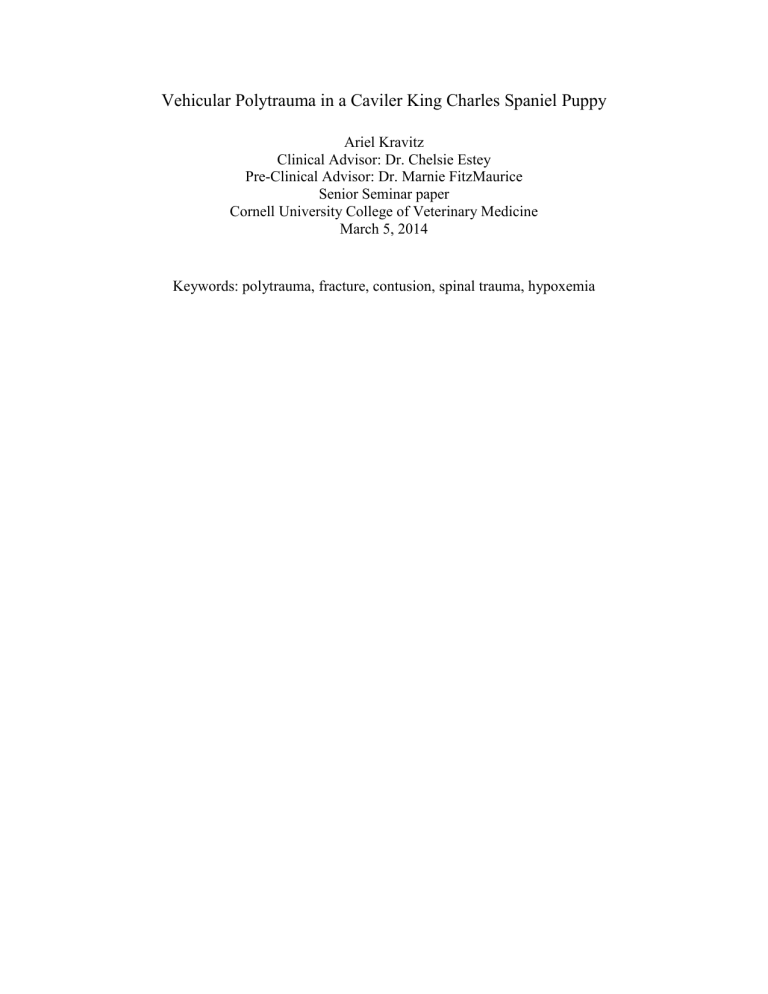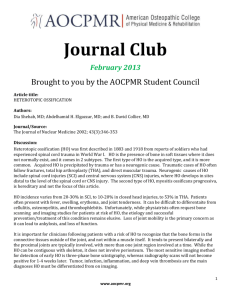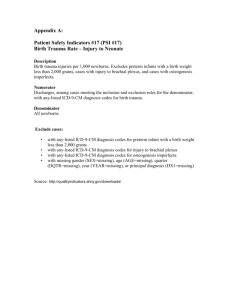Ariel Kravitz paper 2014 - eCommons@Cornell

Vehicular Polytrauma in a Caviler King Charles Spaniel Puppy
Ariel Kravitz
Clinical Advisor: Dr. Chelsie Estey
Pre-Clinical Advisor: Dr. Marnie FitzMaurice
Senior Seminar paper
Cornell University College of Veterinary Medicine
March 5, 2014
Keywords: polytrauma, fracture, contusion, spinal trauma, hypoxemia
Abstract:
A 13-week-old female intact Cavalier King Charles Spaniel presented to the Cornell
University Hospital for Animals Emergency service after sustaining vehicular trauma the day prior. Following the accident, the dog was immediately taken to a veterinary emergency and critical care center. No improvement was observed, and the patient was referred to Cornell.
Initial assessment at Cornell uncovered neurologic deficits that localized the lesion to the
T3-L3 and L4-S3 spinal cord segments. A full body Computed Tomography (CT) revealed injuries to the face, cranium, thorax and cervical and lumbar vertebrae. Surgery was performed to repair the comminuted L4 vertebral fracture. Postoperatively, the patient continued to improve neurologically and was discharged five days after surgery. Recheck appointments, which included spinal radiographs, showed continued neurologic improvement and lumbar fracture healing. This report will explain diagnostic imaging findings along with medical and surgical management of spinal fractures. A discussion of spinal fracture stabilization and prognosis for polytrauma will also be discussed.
Case History:
A 13-week-old female intact Cavalier King Charles Spaniel presented to the Cornell
University Hospital for Animals Emergency Service with a one day history of trauma following being hit by a car. Following the accident, the dog was immediately taken to a veterinary emergency and critical care center. She was treated overnight for shock and cerebral edema. The following morning, the patient was referred to Cornell for further evaluation.
The patient had also been diagnosed with Bordetella bronchiseptica three days prior to the vehicular trauma, and was started on a fourteen day course of amoxicillin/clavulanic acid.
2
She also recently completed several days of deworming with pyrantel and had not yet received any vaccines.
Clinical Findings at Presentation:
On presentation to Cornell, the patient was vocalizing in pain and was taped to a backboard to limit movement. Vital parameters were within normal limits and the patient appeared adequately hydrated. Flow by oxygen was instituted and pulse oximetry revealed a mild hypoxemia, with a SpO
2
of 92-93% at room air. Neurologic examination revealed voluntary motor in all limbs, absent proprioception in the pelvic limbs, decreased withdrawal reflexes in the pelvic limbs, decreased patellar reflex on the right, but absent on the left and lumbar discomfort on palpation. She vomited blood-tinged fluid shortly after admission. An initial blood pressure reading was normal for her age (111/50, MAP=82), but following methadone administration for pain control, she became hypotensive (95/58, MAP=72). A 90 ml intravenous fluid bolus delivered was over 20 minutes. No free fluid was found during both A (abdominal) and T (thoracic) FAST scans. A parvovirus SNAP test was performed and was negative.
The patient was moved to the intensive care unit and was kept in an oxygen cage (40%
O2). Her head remained elevated to maximize venous outflow from brain and subsequently reduce the intracranial pressure. She was given ampicillin/sulbactam and ceftazidime for broad spectrum antibiotic coverage, maintained on intravenous fluids (Plasmalyte + 20 mEq/L KCl plus 1.5% dextrose) and a constant rate infusion of fentanyl (2mcg/kg/hr). She was also given an anti-emetic (ondansetron), a proton pump inhibitor (pantoprazole), and a gastroprotectant
(sucralfate).
Computed Tomography Findings:
A full body CT scan performed under sedation (fentanyl, diazepam, and propofol),
3
revealing injuries to the face, cranium, thorax and cervical and lumbar vertebrae. There were comminuted minimally displaced fractures of the right frontal bone, maxilla and bony orbit. A fluid dense material (presumed to be hemorrhage) was present intracranially (likely intraparenchymal) and intranasally. A gas pocket was also seen intracranially (pneumocephalus).
Thoracic views showed a moderate generalized and asymmetric patchy airspace lung pattern
(pulmonary contusions vs. infectious vs. both). At the C3 vertebra, fissure fractures were present through the right pedicle and both caudal articular processes. The L4 vertebral body had a comminuted fracture that was mildly dorsally displaced into the vertebral canal with suspected compression of the spinal cord.
Surgical Repair:
The next day, the patient was induced and placed under general anesthesia for surgery.
She was then placed in sternal recumbency, clipped, aseptically prepared, and draped in the standard fashion. A dorsal midline incision was made extending from the spinous processes of
L2-L6. The subcutaneous fat and fascia were bluntly dissected, and the epaxial musculature was elevated from the dorsal spinous processes down to their transverse processes bilaterally.
Hemostasis was maintained with electrocautery. The spinous process of L4 was removed, and a dorsal laminectomy was performed over L4 to provide dorsal decompression. The spinal cord was visualized and was bruised with purplish hue. Hemostasis was accomplished by applying bone wax and gel foam. L4 vertebral fractures were visualized on the left articular facet and at midline on the ventral aspect of the lamina. A cortical screw was placed transarticularly through the right cranial articular facet joint of L4. Four screws were placed bicortically through L3 and
L5. The first two cortical screws were placed through the base of left and right transverse
4
processes of L3, respectively. The next screw was placed through the base of the left transverse process of L5. The last screw was placed through the right transverse process and pedicle of L5.
Polymethyl-methacrylate (PMMA) with cefazolin was molded around the screws and flushed copiously until hardened. The fascia was then closed with a simple continuous pattern using 2-0
PDS. The subcutaneous tissue was closed using 3-0 PDS in a simple continuous pattern, and the subcuticular tissue was closed similarly using 3-0 Monocryl.
Treatment and Outcome:
Post-operative CT was subsequently performed to confirm the placement of the implants.
The patient was hypothermic immediately post-operatively, and had a slow, but uncomplicated recovery. She was continued on her original treatment plan (40% O2, Plasmalyte + 1.5% dextrose, fentanyl CRI, ampicillin/sulbactam, ceftazidime, ondansetron, pantoprazole and sucralfate). A lidocaine intravenous constant rate infusion was added for additional pain management, and the incision was iced to decrease pain and swelling postoperatively. The patient did well overnight and had a good appetite, but regurgitated once in the middle of the night and again in the early morning.
The following day, the lidocaine constant rate infusion and sucralfate were discontinued, and the patient was started on pregabalin, and maropitant. The remainder of her treatments remained unchanged. Neurologic examination revealed an appropriate mentation and intact cranial nerves. She had an ambulatory paraparesis with voluntary motor function in all limbs.
The withdrawal, patellar and perineal reflexes were intact, and proprioception was absent in the hindlimbs bilaterally. Her cutaneous trunci reflex was normal on the right and had a cutoff at the level of L3 on the left. The fentanyl constant rate infusion was tapered in morning and discontinued in the evening. The patient did not vomit or regurgitate again.
5
The next day, the patient started having coughing episodes, which were Bordetella-like and worse on expiration. Nebulization and albuterol (a bronchodilator) were started to help open her airways so that she could breathe easier. The cause of the coughing was thought to be attributed to either blood starting to mobilize from the pulmonary contusions, or a sequelae of the
Bordetella . Her neurological examination was unchanged.
The right eye appeared to have more scleral hemorrhage than previously noted. An ophthalmology consult revealed retinal hemorrhage in both eyes, with the left more severely affected and scleral hemorrhage in the right eye. Since the patient was visual, it is expected that the hemorrhage would subside with time.
Another complete blood count (CBC) and Chemistry were submitted to monitor the patient’s progression since surgery and determine whether the current medical therapies need to be altered. CBC revealed a normochromic, microcytic regenerative anemia, likely attributed to the trauma, hemorrhage and surgery. Increased white blood cells were consistent with an inflammatory leukogram, indicating that her immune system was working appropriately to remove harmful stimuli that entered her body post-trauma. Chemistry abnormalities were largely unremarkable and attributed to her age, muscle damage from her injury and being on fluids.
The next day, the patient continued to improve, with her lungs clear, oxygenation improved and no additional episodes of coughing. On neurologic examination, her hindlimb motor function was mildly improved. Her cutaneous trunci reflex was also mildly improved, moving 1 cm closer towards her tail. Additionally, she began her physical therapy program, starting with passive range of motion. In the afternoon, she was taken off oxygen, and was doing
6
really well. She was switched from intravenous to oral antibiotics in preparation to be sent home in the coming days.
The following, the patient was doing well off supplemental oxygen, and her fluid rate was tapered in preparation to go home. Neurologic examination revealed that her hindlimb motor function was mildly improved and her cutaneous trunci reflex was normal bilaterally. The scleral hemorrhage in her right eye was also mildly improved. The patient experienced a few bouts of soft stool throughout the day, and she was given a dose of pyrantel and was started on a course of metronidazole.
Five days postoperatively, the patient continued to progress, and her stool mildly improved. Final neurologic examination revealed a non-ambulatory paraparesis (with improved motor in her pelvic limbs), present reflexes in all limbs, absent proprioception in her pelvic limbs, intact cranial nerves and a slightly hunched posture with mild lumbar discomfort. She was discontinued from intravenous fluids and later discharged to the care of her owners.
At the time of discharge, the patient’s overall prognosis was fair to good. She sustained significant injuries secondary to the vehicular trauma. The facial fractures were not of major concern as her cranial nerves were normal and she did not experience any intracranial neurologic signs. However, it was not known whether the fracture fragments would shift and create additional trauma in the future, especially since she was still growing. Although the fissure fracture at the level of C3 was not causing a problem at that moment, neurologic deficits could still result in the future as she continued to grow or if she sustained any trauma to that area.
Also, due to the fact that she suffered a hematoma in her olfactory lobe, a portion of the forebrain, she was now predisposed to developing seizures in the future.
7
She sustained significant pulmonary contusions. Her lungs were still healing at the time of discharge and continued recovery was anticipated as she tolerated being off of supplemental oxygen very well.
Surgical repair aimed to stabilize the comminuted L4 vertebrae and reduce the likelihood of additional spinal cord trauma. Nevertheless, due to its location, the vertebral body fracture was unable to be repaired in perfect anatomical alignment. Thus, there was still the potential for the spinal cord to be compressed if the fragments dislodge from their current locations or if she sustains any trauma in the future. There was also an increased likelihood for osteoarthritis development in the coming months to years. The patient appeared stable post-surgery, but she still had residual neurologic deficits. At the time of discharge, it was uncertain how long it would take to regain proprioception and it remained unknown whether neurologic deficits would be present long term. Based on the patient’s status and neurologic examination at discharge, she had a fair to good prognosis, with a 60-70% chance to return to normal function. Change of recovery remained highly contingent upon good supportive care in the form of pain control, range of motion exercises and strict crate rest.
Recheck Examinations:
The patient had her first recheck appointment four weeks after surgery. Neurologic examination revealed appropriate mentation, absent menace bilaterally and normal reflexes in all limbs. She had mild hindlimb spinal ataxia, with absent postural thrust on the right, delayed postural thrust on the left and normal placing in all four limbs. Pain was elicited on head palpation, as well as at the cranial cervical and thoracolumbar spine. Neurolocalization was localized to the thoracolumbar spine (T3-L3). Spinal radiographs were taken to assess the placement and viability of her implants. The comminuted L4 vertebral fracture was healing,
8
with callus formation present at the caudoventral aspect of L4. All implants were in their proper locations and no radiolucencies were seen. This suggested that there was no evidence of infection or implant failure.
The patient returned for her second recheck appointment at 10 weeks postoperatively. On presentation, the patient was bright, alert, responsive and ambulating very well. Neurologic examination revealed an improved ambulatory paraparesis with mild hindlimb ataxia, delayed hopping on the right pelvic limb and normal hopping in other limbs. She also had normal reflexes in all limbs, appropriate mentation, intact cranial nerves and no pain elicited on palpation. Radiographs of her lumbar radiographs were again taken to assess healing and implant stability. The L4 vertebral fracture was healed and all implants remained stable in their appropriate locations.
Discussion and Prognosis:
Trauma is the second most common cause of death in juvenile and adult dogs
1
. A subcategory of this, vehicular polytrauma, is a type of high energy blunt injury. It is the most common cause of vertebral fractures in dogs. One study, evaluating patients of vehicular trauma, cited that long bone fractures, pulmonary contusion and pelvic fractures were sequentially the most frequent types of injuries, followed by hemoabdomen and soft tissue injury 2 . Additionally, approximately 20% of these patients have a second spinal fracture or luxation and 40-50% have concurrent injuries
3
. It is also important to note that physical examination findings are more sensitive than radiographs in diagnosing injuries following vehicular trauma
4
. Thus, diagnostic exam finding should always be evaluated in conjunction with physical examination findings.
Although not performed in this case, an animal trauma triage (ATT) score is commonly utilized to assess the severity of injuries in veterinary trauma patients. This scoring system is a
9
grading scheme that appraises a patient's perfusion, injuries to eyes, musculature, integument and the skeletal system and cardiac, respiratory, neurologic statuses 5 . The ATT was found to be a good prognostic indicator of outcome, with ATT score being significantly related to outcome
2
.
Regarding spinal trauma, patients with vehicular trauma can incur both primary and secondary spinal cord injuries. Primary spinal injury occurs immediately following the trauma.
The spinal cord undergoes mechanical damage that can result in contusion, shearing and compression 6 . This causes physical disruption of cell membranes, resulting in physical disruption of neuronal and glial cell membranes
7
. Secondary spinal injury is the result of a biomechanical process triggered by the primary injury and can occur hours to days following the trauma. This ultimately causes propagation of the initial spinal cord injury and can lead to additional problems. Such complications include oxidative injury, local and systemic inflammation, and continued neuronal cell death 6 .
When discussing primary spinal trauma, it is important to address the three compartment model. This model partitions the bony and soft tissue structures surrounding the spinal cord into dorsal, middle and ventral sections. The dorsal compartment consists of the the spinous processes, articular facets, laminae, pedicles and supporting ligamentous structures. The midddle compartment consists of the dorsal longitudinal ligament, dorsal aspect of the annulus and dorsal aspect of the vertebral body. The ventral compartment encompasses the nucleus pulposus, ventral and lateral aspects of the vertebral body and the ventral longitudinal ligament.
If more than one compartment is affected, this signifies that the injury is unstable
6
. This case demonstrated the clinical application of this model, as the L4 vertebral fracture was found to be unstable due to the fact that both the middle and ventral compartments were affected.
10
When treating a patient with spinal trauma, goals of management aim to prevent ongoing primary injury and allay perpetuation to secondary injury as well as stabilizing a fracture. The latter in itself is based on the specific structures that are damaged and the forces acting on them
7
.
Goals of surgical repair include realignment and stabilization the spinal column and decompression of the spinal cord. There are also various surgical techniques available, which reflects that there is no one method that works best for every situation. Of the described surgical techniques, pins and polymethyl-methacrylate (PMMA), external fixation and locking plates are the most versatile options. Other possible techniques include vertebral body plates, modified segmental fixation, tension ban stabilization and spinous process plating
3
.
Overall prognosis for spinal trauma largely depends on the degree of spinal cord injury and how the patient is managed in both the short- and long-term. As recovery may take several weeks or months depending on the severity of injury, prognosis is largely contingent upon appropriate at home management. A critical prognostic factor is a patient’s nociceptive status
3
.
Patients with some voluntary motor function, and thus the presence of pain perception, are said to have a good prognosis, while plegic animals with nociception are thought to have a fair to guarded prognosis. In contrast, patients without nociception are considered to have a very poor with approximately 5% regaining voluntary motor function 4 .
11
References:
1.
Fleming J.M. et al. Mortality in North American dogs from 1984 to 2004: an investigation into age-, size-, and breed-related causes of death. Journal of Veterinary
Internal Medicine. 2011 Mar. 25(2), pp 187-98.
2.
Streeter, E. et al. Evaluation of vehicular trauma in dogs: 239 cases (January–December
2001). JAVMA. 2009 Aug. 235 (4), pp 405-408.
3.
Fossum, T. Small Animal Surgery. 1 st ed. pp 1118-1127. Mosby and Co., 1997. St. Louis,
Missouri.
4.
Tobias K, Johnston S: Veterinary Surgery: Small Animal. 1 st
ed. pp 487-496.
Elsevier/Saunders, 2012. St. Louis, Missouri.
5.
Rockar, R.A., Drobatz K.J., Shofer F.S. Development a Scoring System for the
Veterinary Patient. Journal of Veterinary Emergency and Critical Care. 2007 Jul. 4 (2), pp 77-83.
6.
Dewey, C. A Practical Guide to Canine & Feline Neurology. 2 nd
ed. pp 405-414. Wiley-
Blackwell, 2008. Ames, Iowa.
7.
Olby, N. The pathogenesis and treatment of acute spinal cord injuries in dogs. 2010 Sep.
40(5), pp791-80.
.
12







